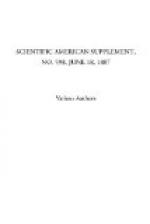First: The material must be considered. Heavy and hard materials, such as wood and stone, will not admit of as delicate curves and lines as textile fabrics, such as cotton and woolen goods, laces, etc.
Second: The manner in which the article is to be made, whether by weaving, cutting, carving, casting, etc.
Third: The position the object is to occupy. If elevated or otherwise remote from the eye, elaborate finish and minute detail are useless. Ornamental art, from time immemorial, has attained its greatest excellence and exercised its greatest influence in connection with architecture.
In fact, the study of ornament is inseparable from that of architecture. It is upon architectural forms that the greatest artists have in all ages expended their greatest efforts and skill, and in a treatise on historic ornament they are decidedly the most interesting and important object of study.
IV. Material of Ornament.—The two great sources of ornament are geometry and nature. The latter includes the former; for not only must natural forms, in order to be available as material for ornament, be first conventionalized, or reduced to regular, symmetrical, geometric outlines, but any and all designs, whether the unit of repetition be geometric or conventional, must be founded upon geometric construction. This refers to the regularity, repetition, and distribution of parts; so that every good design, if reduced to its principal lines of construction, would exhibit but a few geometric lines and inclosing spaces. Many designs are not only geometric in their basis or plan, but make use of geometric figures as the units or materials of design. Such designs, however, rank lower than those in which natural forms conventionalized are taken as the subjects of repetition; and as the ornament rises in the scale toward perfection, even the geometric basis becomes less and less apparent, and sinks into a decidedly subordinate position; so that in many of the most perfect specimens it can be traced only in a few leading lines of the composition. Its presence, however, is necessary, and is the foundation, if not the most important element, of beauty in the design.
RELATION BETWEEN NATURE AND ORNAMENTAL ART.
While the natural world, including leaves, flowers, animals, etc., is the greatest source of ornament, it is generally the opinion of the best authorities, derived from the study of the best styles and by a consideration of the principles of fitness and propriety which underlie the entire physical and moral world, that natural forms in ornamental and decorative art should not be literally copied or imitated. That is the aim of painting, sculpture, and the other representative arts, where the object is to present something to the eye which will suggest at once the actual presence of the object. To produce that effect, the object, whether animal or vegetable, is represented as much as possible in the actual circumstances of its existence, surrounded by the necessary conditions of its well-being and growth. A frame is placed around it, to shut it off as much as possible from other surroundings, and thus help us delude ourselves that we are in the presence of the real thing, either as it would impress us through our senses or our imagination.




